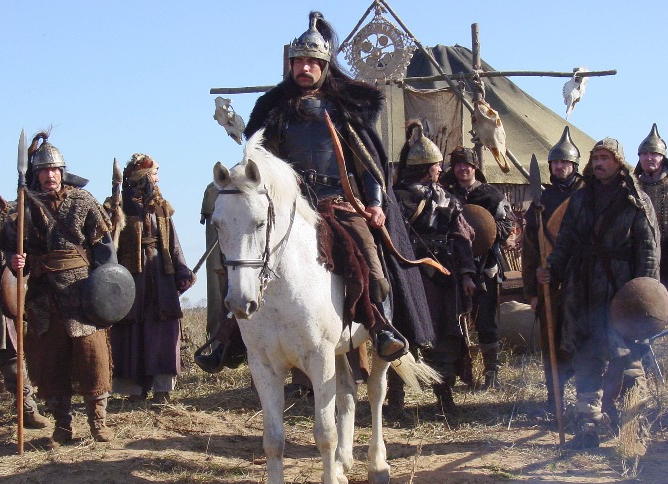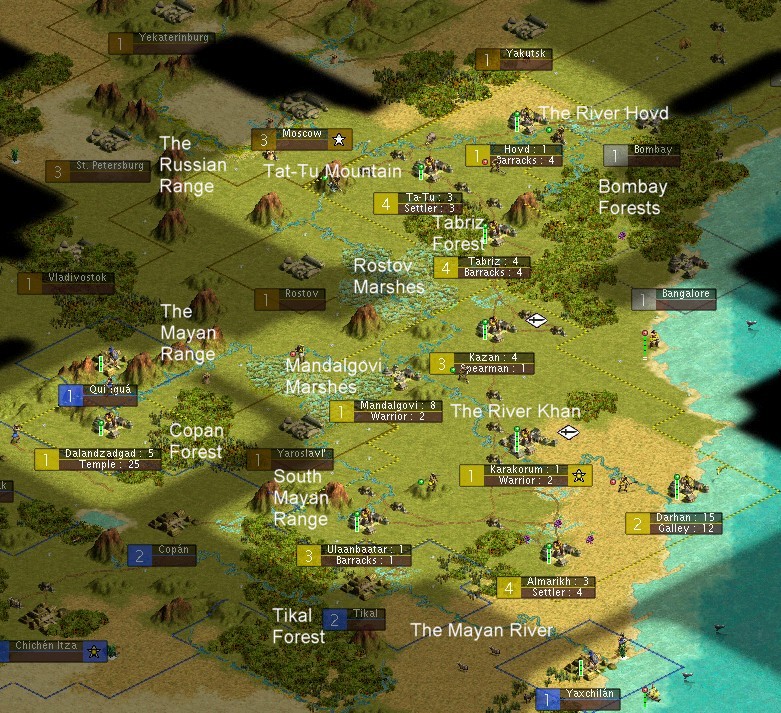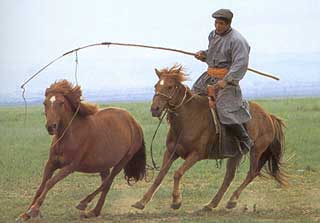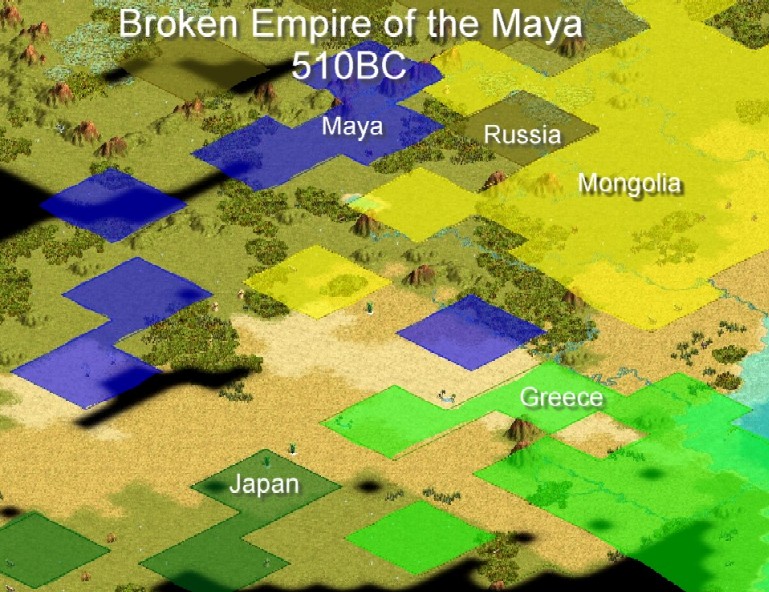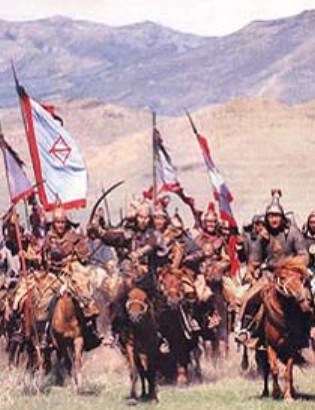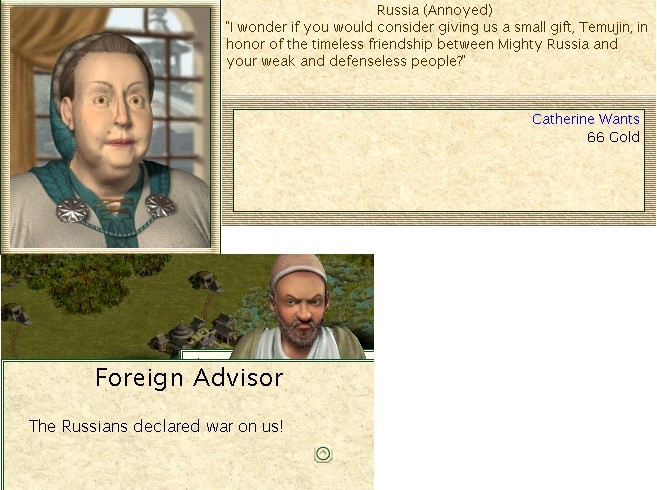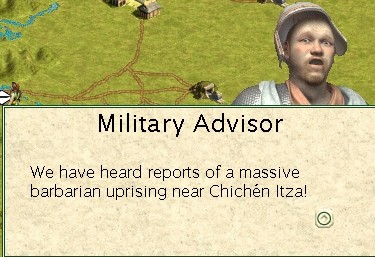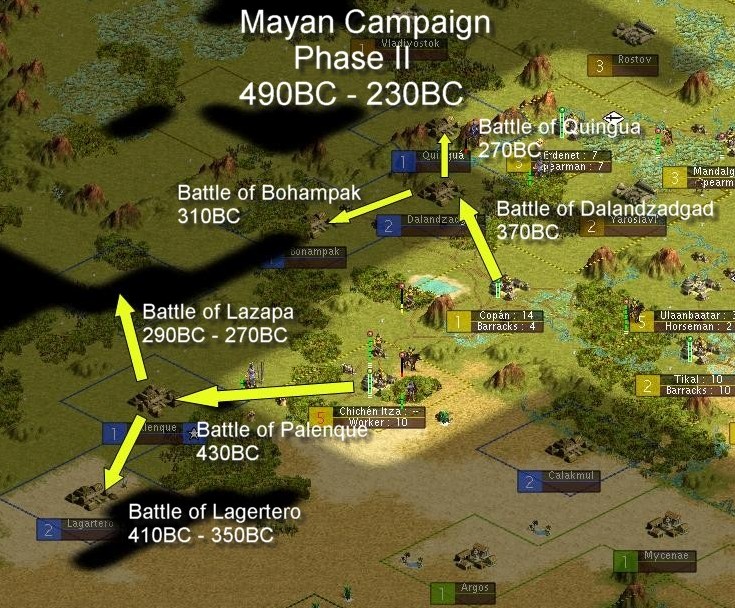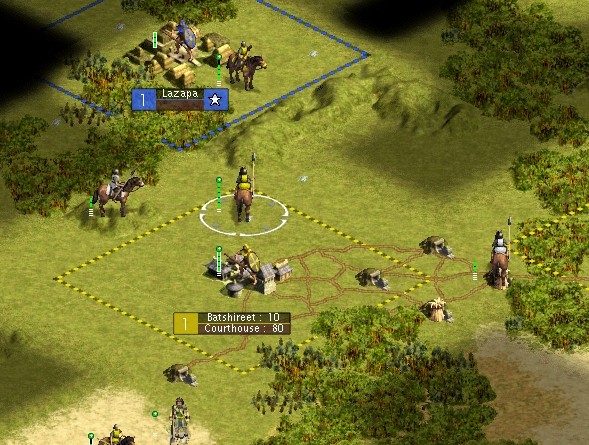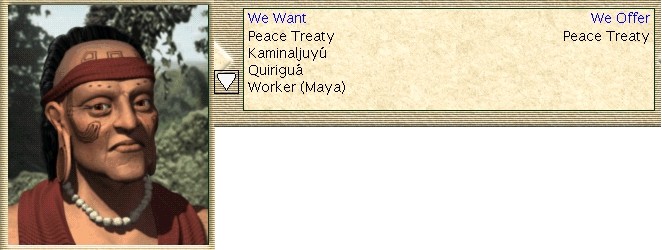Chapter Two:The Seeds of War
Subtitle: The Horse Wars
At the turn of the millennium, the Mayans were claiming the herd of horses by Ulaanbaatar as their own. The fact that these animals were closer to Ulaanbaatar, and even more importantly were the sacred instrument of the Mongol people meant little to the heathen Smoke-Jaguar..
War did not break out immediately. The Great Khan earnt his title, and it was not awarded for foolishness. Given the future military preparedness of the Mongol hordes, it may came as some surprise to the reader that the military force at this time was in fact quite weak. The Greta Khan had at his disposal only 800 poorly equipped warriors, and a further 200 of the better equipped defensive spearmen. It turned out that the iron source at Mount Tat-Tu had not been accessed at that point, and it would in fact be a further 150 years before this resource was available to him.
The Khan spent this time well. In 975BC, the Khan’s first grandchild founded Cloybalsan. 975BC also heralded the time when the 14th tribe was located on the far western perimeter of the world. The tribe had nothing of value ot offer to the Mongols, however. Further cities were founded in 950BC (Erdenet), in 850BC (Tsetserleg) and in 775BC (Baruun Urt).
Trade continued to blossom with his neighbours. In what seemed a most surprising move, first China, then Russia sold their own people into a life of slavery in exchange for the slowly dating technology philosophy. The Khan could not understand a people who had so little pride in their own that they could commit them to such a life, but he was more than prepared to take advantage of it.
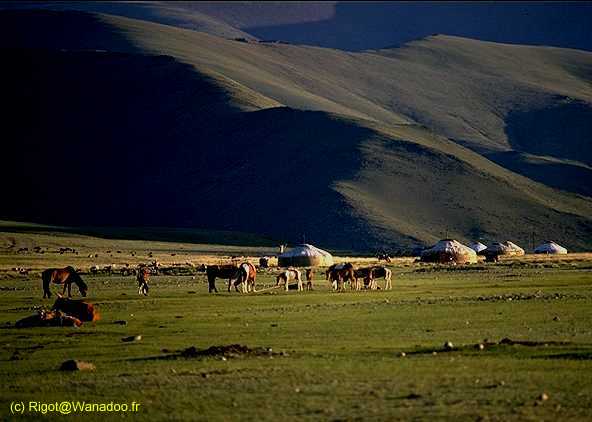 The cherished resource so tantalizingly close, and yet so far
The cherished resource so tantalizingly close, and yet so far
The event that sparked the Khan into action was the Japanese declaring war on the Mayans in 875BC. This drew much of the Mayan forces off to the south west. In doing so, the eastern Mayan cities, that is to say the ones nearest to the Khan, became relatively more weakly defended. The timing could not have been more perfect if the Khan had planned it all out himself, and perhaps in fact he did. Only 25 years later the iron resource came on line, and allowed for the immediate upgrade of 1000 foot soldiers forming 10 regiments of the powerful swordsmen units. While these soldiers were not the Khan’s preferred means of taking the battle to his enemies, the engineering feat required to access the horse supply by Dalandzadgad was still many centuries from completion.
These new soldiers were rebased out of Ulaanbaatar, just to the north of the horses, and the offending Mayan city of Tikal. With 1000 troops and more on the way, the Khan felt confident that the time to liberate the horses was now. So in 730BC the Mayan diplomat was called before the Khan. It had come to the Khan’s attention that Mayan workers were trespassing upon sacred Mongol territory, so the Mayans were invited to remove these trespassers immediately, or offered the opportunity to declare war. This was in fact a test of the Mayan resolve. The Great Khan had no interest in peace; he merely wished to know what sort of mettle these Mayans would provide in battle.
The weak concession to his demands was all the Khan needed to hear. Suspecting weakness in his enemy, the Khan immediately made a declaration of war and ordered the advance on Tikal. A force of 1000 men started the advance. It consisted of 900 of the well equipped swordsmen, backed up by 100 of the heavily armoured spearmen.
The Battle of Tikal occurred in 710BC, and will be remembered as one of the bloodiest battles of the whole war on both sides on the conflict. Before it was over 400 Mayans and 300 Mongols were left dead in the battlefield. The Mayans lost equal numbers of spearmen and javelin throwers, while the Mongols lost swordsmen. But despite being bloody, the battle was a complete success for the Khan. The town of Tikal and the horse herd held in its thrall both entered the possessions of the Mongols.
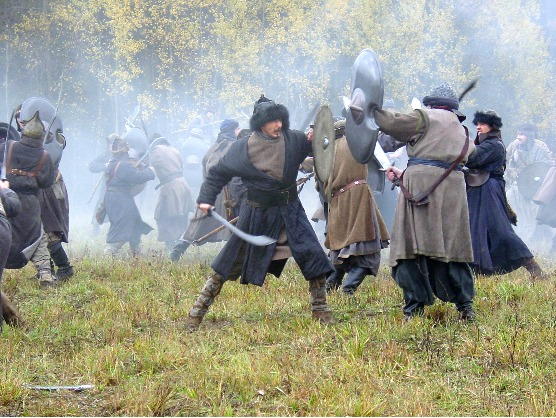 The Battle of Tikal
The Battle of Tikal
To die in battle is no dishonour within a warrior clan, and so there was much rejoicing across the Mongol empire at the news, and an expectant audience eagerly awaited more. They were not to be left waiting for long. The Mayans proved to have more battle mettle than their early weak concession seemed to imply for in 690BC they launched a surprise attack on the town of Dalandzadgad.
Dalandzadgad was the chosen site for the founding of a town by the Khan’s ninth born. It had the defensive advantage of being located on a hill. It had access to freshwater as it was by the western source of the River Khan, and best of all a herd of the sacred horses. But the Khan saw through these advantages to the weaknesses of the site. It was very isolated from the core of Mongolia, blocked by both the Mandalgovi Marshes, and the Russian city of Yaroslav. It was also dangersously close to the then potential enemy of the Mayans. In the Khan’s mind these things outweighed its positives, but the ninth born was not to be moved in his determination, and so the city was founded.
True to form, the Khan’s fears were realised. The town was only garrisoned by 100 lightly armed warriors at the onset of war. Isolated as it was, it was not possible to get reinforcements through to the town in time. So that when the Mayan horse regiments gathered within sight of the town, it was already too late. Two hundred horse borne soldiers attacked the light defences. The Mongols were fiercely loyal however, and were able to repulse the first full regiment of horses at the cities gates. But this fierce spirit was insufficient against the superior numbers and better equipment of the enemy, and so inevitably the town fell into Mayan hands.
However, the Khan would have his revenge. As the damaged Mayan horse regiment retreated into the Mayan Mountain Range, it was tracked by Mongol spies. As soon as the new Mongol horse regiments were formed, one pursued the enemy into the mountains and slaughtered the troop down to the last man. The message was clear – do not cross the Khan!
Smoke-Jaguar’s favourite past-time was to take his bong into the depths of the Tikal forests. And yet, after the terrible toll he his forces had already taken in this war with the Mongols, he found that he was no longer able to find solice in this activity. On the advice of his trusted council, Smoke-Jaguar approached the Greek ambassador and proposed a joint action against the Mongols. Alexander was only too willing to join in the action and so immediately delivered a war declaration to the Khan.
This new development in the war was not well received by the Khan. The conflict was between the Mongols and the Mayans. It was dishonourable to bring others into this private dispute. However, this action truly presented a danger to the Mongolian empire because the Greeks had their fanatical hoplite defenders, and the Khan had no wish for a war on two fronts. Thus the Khan took action. The militant Japanese were located directly on the other side of both the Greeks and the Mayans, so for the price of a mutual alliance against the Mayans, the Japanese agreed also to take the war to the Greeks. For good measure the Khan brought the Portuguese into the conflict against the Greeks as well, although it was rumoured that a substantial amount of gold was required to gain the Portuguese commitment.
It should be noted that there were other important events occurring around the world at this time, beyond the grisly conflict between Mongol and Maya. First the tribe called the Babylonians completed a structure known as the Great Library that promised to keep them at the forefront of technical know-how for some time to come. Second, the Khan’s scouts were still hard at work peeling back the fog of war. In 650BC contact was at last made with the tribe called the Netherlands, though this tribe had no relevant secrets to trade for. This brought the known tribes of significance to a staggering 15.
The militant citizens of Mongolia greeted the news of the expanded conflict warmly. As a deserving tribute to the Great Khan, a magnificent two story palace was erected in his honour.
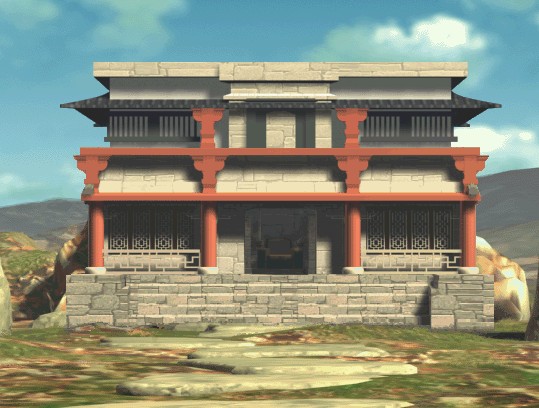 The new Palace
The new Palace
It was at this time also that the Mayans launched their assault on the town of Baruun-Urt. 100 Javelin throwers stormed the gates of the town, but were unable to breech the 100-strong spearmen defense found there. For some reason known best to Smoke-Jaguar, a further regiment of javelin throwers stayed fortified within Mongol territory and within range of Baruun-Urt. Perhaps the one sided defeat of their comrades made them see another side to valour, or perhaps that true concessionary nature of the weak Mayan civilisation had finally come to the fore on the battlefield.
630BC also saw another bloody sword battle at the Mayan town of Copan. The Khan was rushing horse units into the battle, but they had quite some distance to travel to reach the front lines. In the meantime, the slower sword units still had plenty of fight left to offer the Mongols. In another victorious Mongolian assault, a further 200 swordsmen gave their life to the cause, while the enemy lost 200 javelin throwers and 100 spearmen. Another Mayan javelin regiment encountered the advancing Mongolian horses, but the battle was inconclusive.
Over the next few decades the action in the war shifted to the south around the Mongol town of Baruun-Urt, and the Mayan town of Yaxchilan. It was here that the Mayan losses continued to mount. A further three hundred javelin throwers and two hundred spears died in and around this conflict, while the Mongols lost just 100 horsemen. Such was the ferocity of this conflict that there was nothing left of the town of Yaxchilan when the dust finally cleared.
Mongol troops were now advancing to the very heart of the Mayan empire, the capital Chicken Itza was now clearly in their sights.

On the way to Chicken Itza, important events were happening at home, and abroad. First the poor excuse for soldiers, Portuguese, pulled out of the conflict with Greece early. Second, an exchange of technology with the Chinese saw the Mongols learn the secrets of Construction. There remained but one technology keeping the empire in the realm of the Ancient techs. About this time also, the Indian ruler, Ghandi stupidly thought that the Great Khan would be distracted by the ongoing warring, and that he could use the opportunity to try and sneak settler caravans through the sacred territory of the Khan. This blatant act was right on the back door of the Khan himself and certainly did not go unnoticed. The Indians were immediately brought before the Khan, reprimanded for this stupidity and given just one chance to withdraw their offending caravans. Naturally, the weak Indians complied with this demand.
On the eve of the mighty battle for Chicken-Itza, a Mayan warrior regiment was attacked by Erdenet, and a regiment of javelin throwers on their way to reinforce Chicken-Itza was cut down by a Mongol horse regiment.
Finally, the day had come. It was 510BC. This battle was to be a combined force of 200 swords and 400 horsemen, lined up against the weakening Mayan defence. Even before the attack horn was sounded, units were seen escaping from the doomed city to maybe disband, or maybe fight another day. Perhaps they had actually overestimated the full siz of the attack, because in the end all 600 men were deployed against the city, and while the Mongols suffered no significant loss, the defence of 200 spearmen and 200 javelin throwers was cut to shreds in the attack. Finally the mighty city that was the heart of Smoke Jaguar’s power was seized from his grasp. With it, the structure that was the pride of the Mayan nation, the Oracle, fell into the hands of the Mongol hordes. It was also decisive in another respect. For with the loss of this town, the Mayans no longer had a cohesive empire. The Mayan empire was now disjoint and all but sure to collapse within the near future.
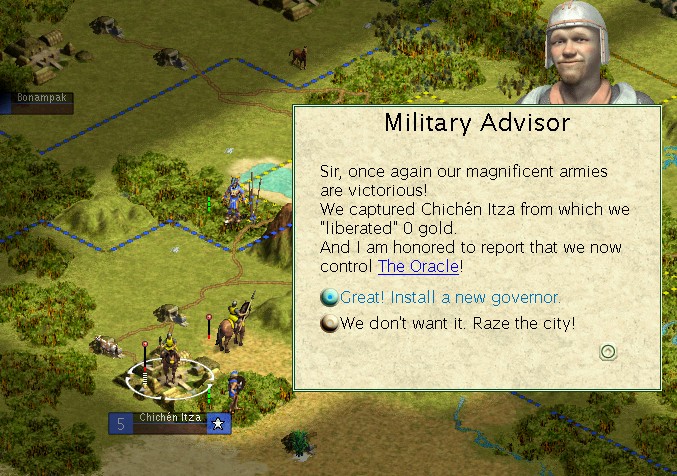
And what of the Japanese and the Greeks? Well some commemtators doubt that their hearts were really in the fight. There were skirmishes near Nagoya over a substantial period of time, but neither side gained any ascendency in this matter, in spite of committing a steady stream of troops to the front.

 Sandman is doing another story
Sandman is doing another story 
